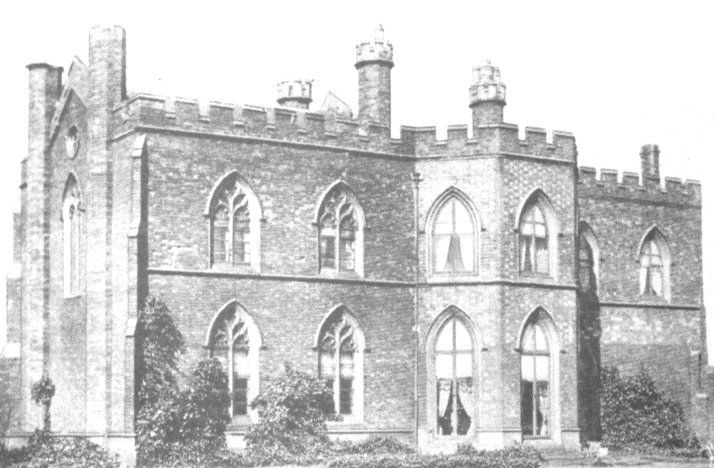
Toll End Hall was built in about
1760 and later the home of the Bagnall family who were
ironmasters. It was later owned by James Solly the
industrialist from Great Bridge. |
|
In the latter part of the 19th century, Tipton and the
neighbouring towns became more prosperous thanks to the
many industries that thrived in the area. Employment was
high, and numerous businesses were set up to supply the
needs of the local population, which increased as people
moved into the area to find employment. |
| |
|
| View the Tipton entry
in Harrison, Harrod & Company's 1861 Directory |
 |
| |
|
|
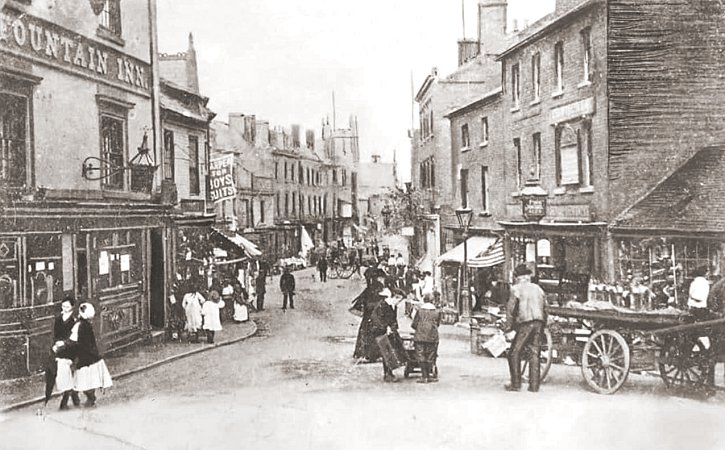
Owen Street. From an old
postcard. |
|
Post Office
One of the amenities that
appeared in the late 1840s was the town’s first post
office, which opened in a small part of a house at
Dudley Port, on the corner of Park Lane and Horseley
Heath. The original postmaster was Mr. Partridge,
who was succeeded by his sister Martha Partridge.
After her death, her niece, Miss Baker took over in
1866. In the early years, letters were received and
despatched twice a day.
At first, mail was conveyed on
the stage coach that ran between Worcester and
Birmingham. The horses were changed at Kidderminster
and at the ‘Swan’ at Swan Village. There were two
letter carriers who sorted the letters in an
outhouse attached to the post office, before making
deliveries. Letters cost one pence or two pence to
send.
The post office was soon
enlarged and took over the whole of the front room
of the house. Sub post offices soon opened at Great
Bridge, Tividale, Tipton Green, Princes End, Ocker
Hill, and Burnt Tree. When parcel post was
introduced, the main post office was again enlarged,
so as to cover the whole of the ground floor. The
average number of letters etc. handled by the post
office increased from 16,700 in 1861 to 43,700 in
1891. Similarly the number of parcels and telegrams
rapidly increased.
In June, 1888, Mr. John Lees
Taylor became postmaster. Around the same time,
eight additional wall boxes were erected in various
parts of the parish and the main office remained
open until 9 pm. for telegrams. Some of the early
postmen, including George Whitehouse, who worked
from Great Bridge became well known local figures.
On the 21st December, 1896 a
splendid new post office, designed by Henry Tanner,
opened at 36 Horseley Heath, at its junction with
Horseley Road. In 1904, on weekdays, it opened from
half past six in the morning until ten o’clock at
night, with four daily parcel deliveries. By 1912,
Robert Crerar had become postmaster. |
|
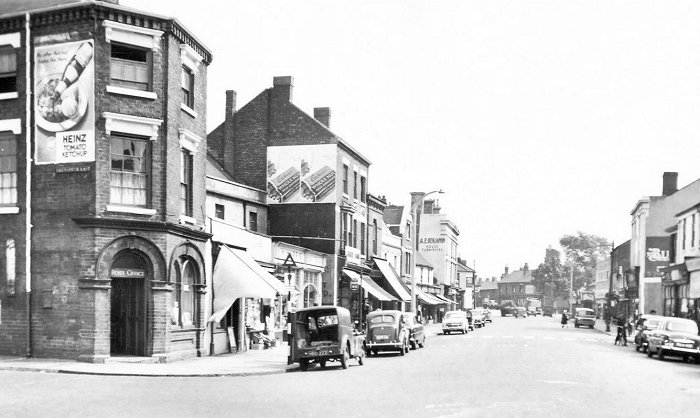
Great Bridge Post Office. From an
old postcard. |
|
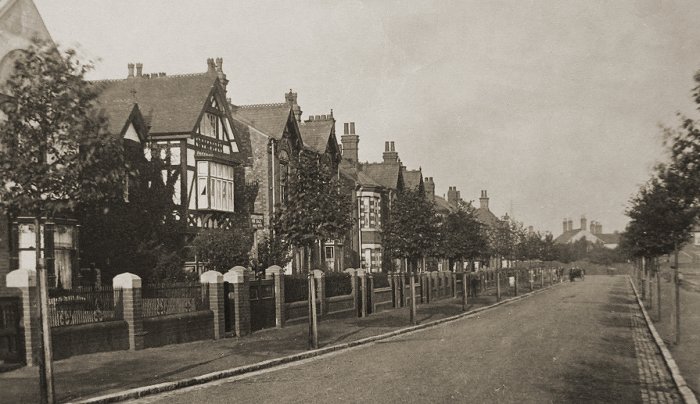
Castle Road, Tipton. From an
old postcard. |

The main entrance to Tipton
Cemetery in Alexandra Road, with the lodge on the
extreme left. From an old postcard. The spire in the
background was in the centre of two mortuary chapels,
now demolished. The cemetery was opened in March 1873 by
the Bishop of Lichfield, Dr. Maclagan. |
| Police Station In 1864, Tipton's police station in Lower Church
Lane opened in a fine blue-brick building that also
housed the magistrate's court. By 1912 there were three
other small police stations in the town. Lower Church
Lane Police Station survived until 2006, when it was
demolished and replaced by the current building, which
opened in March 2007.
The Coneygre Reservoir
The South Staffordshire Waterworks
Company decided to build a reservoir and a pumping
engine to boost the supply of water to Dudley and West
Bromwich. The plan was to build a reservoir at Hill Top
over the railway tunnel in Tunnel Street, but the Great
Western Railway refused to allow its construction.
After this disappointing start, the
company managed to purchase six acres of land on the
Coneygre Estate from the Earl of Dudley, at a cost of
£3,744. Work on the open reservoir began in 1861. It was
built by John Aird & Sons of London and had been
completed by March 1862. The reservoir was on the
southern side of Park Lane West, to the north of the
Birmingham Canal. The reservoir was 200 feet wide (at
its widest point) and could hold eight million gallons
of water, none of which went to Tipton.
There were two 50 hp. steam engines
and four Cornish boilers, housed in a building close to
the canal, to allow for the easy delivery of consumables
etc. The engines used around 4½ tons of coal every
twelve hours, which mainly came from the nearby mines,
owned by the Earl of Dudley. The reservoir operated in
conjunction with a higher reservoir at Shavers End,
Dudley, where water could be pumped when necessary along
a 15 inch water main that was laid alongside the South
Staffordshire Railway Line which ran to Dudley. The
reservoir ceased to be used in 1876, but the pumping
engines continued in use for some years to boost the
water supply to the higher parts of Dudley.
As the water evaporated and the
reservoir emptied, it was used as a site for tipping
surplus soil. A house was built alongside the reservoir
in 1881 and 1882. It was used as part living
accommodation and part offices for the Tipton waterworks
superintendent. Today the site is used for the storage
of pipes etc. and is now occupied by Integrated Water
Services Limited.
Tipton Gas Works
Tipton’s first gasworks officially opened on Saturday
the 1st July, 1882. It stood on a site that had been
purchased from the Tipton Green Colliery Company by the
Local Board. Its location was between the Stour Valley
Railway and Workhouse Lane (now called Alexandra Road),
about 200 metres from Tipton Railway Station. There were
sidings from the railway and a canal basin so that coal
could easily be transported there. The gas works
produced town gas by heating coal in retorts. For many
years Glover West vertical retorts were used, until 1954
when they were replaced by a Woodall Duckham vertical
retort plant, which operated until 1960.
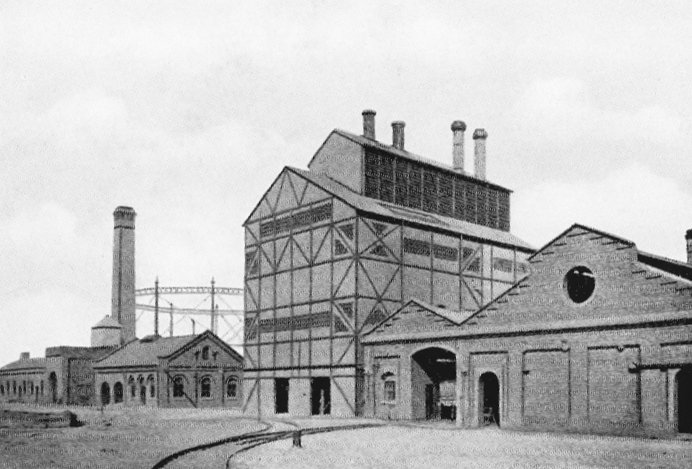
The gas works.
Coal was delivered to the stockyard by rail where it was
tipped from wagons by a rotary tippler and dropped into
a crushing machine before being piled into a heap, which
was continuously monitored for temperature changes, due
to the danger of spontaneous combustion.
Coal was transferred to the retort
house in one of two continuous bucket conveyors that
carried it to the coal storage bunkers from where it
passed through a gas-tight valve into a much smaller
hopper, which opened directly into a retort. In the
retort it was heated up to 1300°C and the gas given off
was removed through pipes for purification.
Eventually the coal was turned into
red hot coke that was quenched by a steam jet. The coke
was dropped into one of two longitudinal conveyors and
transported to the screening plant where it was graded
into sizes and stored in large bunkers, before being
sold.
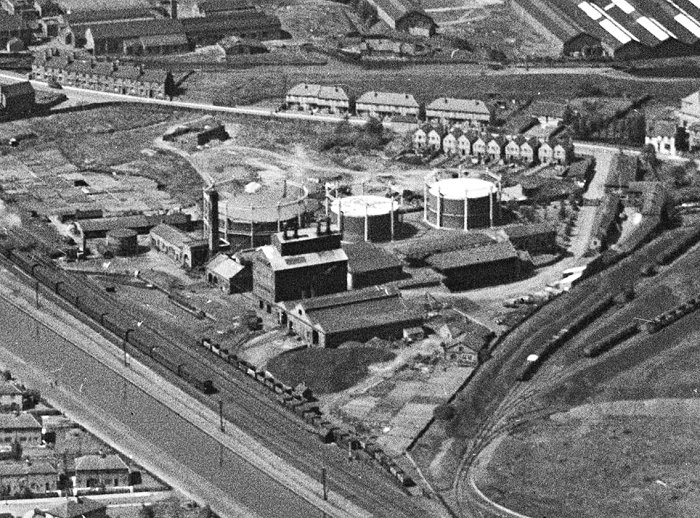
Tipton Gas Works.
Impure coal gas was taken from a
retort through a cast-iron off-take pipe where any
solids were removed. The hot gas then passed through the
primary condenser where the bulk of the tar and some of
the ammonia were removed to leave partially clean gas.
This then passed into a large cast-iron ammonia scrubber
where layers of wooden grids, sprayed with softened
water, created a large wet surface that readily
dissolved any ammonia in the gas.
The gas continued its journey by
passing through secondary condensers that removed any
remaining ammonia before passing through layers of
iron-oxide to remove hydrogen sulphide. The gas was now
sufficiently pure and passed through a gas meter before
being stored in one of Tipton’s four gasholders.
The by-products from the manufacturing process were all
sold, including tar, ammonia, coke, and sulphur. The tar
was pumped into a storage tank before being delivered to
Midland Tar Distillers by canal boat.
|
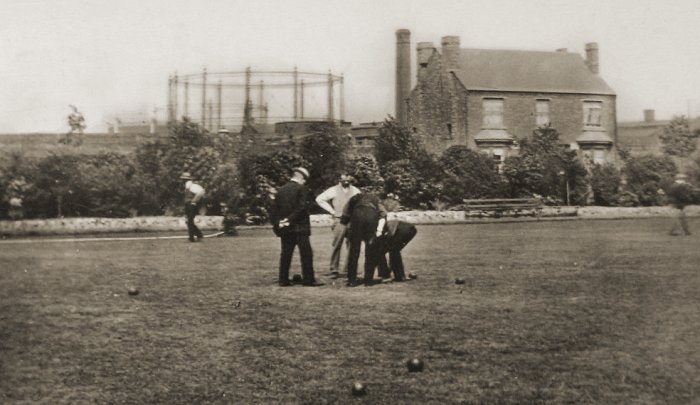
Tipton Gas Works seen
from the bowling green in Victoria Park.
From an old postcard. |
The Mond Gas Works
To the east of Tipton Gas Works was
a site occupied by the South Staffordshire Mond Gas
Company that produced Mond gas for power
and heating purposes. The gas was supplied to a large
area stretching from the edge of Birmingham to the
boundary of Wolverhampton, and as far as Pelsall and
Stourbridge. It was formed by an Act of Parliament in
1901 to make and distribute producer gas across an area
of 123 square miles. Mond gas was a variant of
producer gas in which coal was completely converted to
ash, rather than to coke, as would happen in a retort.
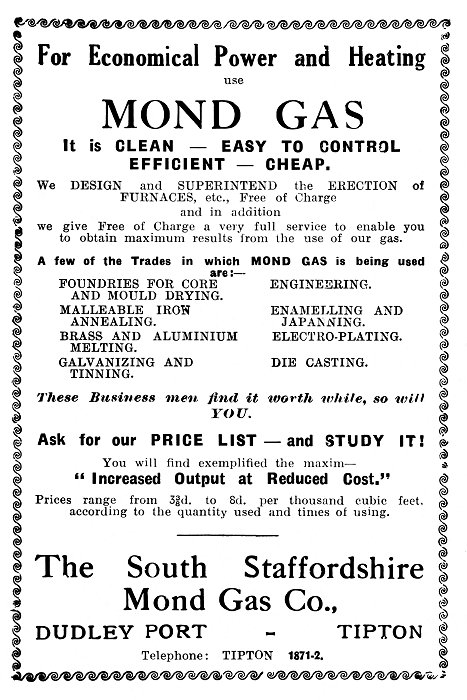 |
The site at Tipton was built in
1902, beside the Stour Valley Railway Line and the
Dixon’s Canal Branch, just to the east of Tipton’s Gas
Works. It was the largest example of a producer gas
plant in the UK.
The plant had 32 producers, capable of
handling over 600 tonnes of coal per day. Most of the
plant, including the producers, the ammonia recovery,
gas washing and cooling equipment were all duplicated to
ensure a reliable supply.
The gas was compressed and
distributed from the plant at a pressure of 10 pounds
per square inch into asphalt-covered steel gas mains.
This was the first example of a
high-pressure gas network in the UK. Later the plant was
fed from coke which resulted in gas with a lower
calorific value. When this happened, gas from the plant
had to be mixed with conventional coal gas from Tipton
Gas Works, to enrich its calorific value. The Mond gas
works closed in 1963. |
|
A report of the
Institution of Mechanical
Engineers visit to the South
Staffordshire Mond Gas (Power
and Heating) Company in 1910
The South
Staffordshire Mond Gas (Power
and Heating) Co. was formed by
special Act of Parliament in
1901 to make and distribute gas
for power and heating purposes
over the area extending from the
City of Birmingham boundary on
the one hand to the
Wolverhampton Borough boundary,
and from Pelsall to Stourbridge
on the other; an area of about
123 square miles, having a
population of very nearly
three-quarters of a million, and
comprising the Boroughs of
Dudley, Smethwick, Walsall,
Wednesbury, West Bromwich, and
Wolverhampton; the Townships of
Amblecote, Bilston, Brierley
Hill, Coseley, Darlaston, Heath
Town, Lye and Wollescote,
Oldbury, Quarry Bank, Rowley
Regis, Sedgley, Short-Heath,
Stourbridge, Tipton,
Wednesfield, and Willenhall; and
the Districts of Halesowen,
Kingswinford, and Walsall
(including Bentley). It is what
may very aptly be termed the
industrial heart of England. The
site at Dudley Port, Tipton,
covers an area of about 40
acres.
The first
section of the works was begun
in 1902, and completed and gas
made early in 1905. The plant
comprises eight producers, each
capable of gasifying 20 tons of
fuel per day of 24 hours, and
generating sufficient gas to
drive gas-engines of 2,000 hp.
continuously. The total capacity
of the present section is thus
equal to 16,000 h.p. The fuel is
brought by boat into the canal
basin, or by rail on to the
siding, both of which have been
specially constructed, and is
unloaded by hand into bunkers;
the entrance to these from the
boats is a little above
water-level, and at the
ground-level from the trucks.
From these
bunkers the fuel is
automatically fed into two
"Hunt" conveyers, each having a
capacity of 40 tons per hour,
and which convey and distribute
the fuel into the storage
bunkers over each set of
producers. The bunker over each
producer will hold 40 tons. The
conveyers are driven
electrically, the motors being
about 5 hp.
The gas
after leaving the producers—at
about 550° C.—is thoroughly
washed in mechanical washers,
and after passing through the
ammonia recovery and gas-cooling
towers, is further purified by
large centrifugal fans (two of
which are running in series at
850 revolutions and are driven
by motors of 45 hp. each), and
then passed through the
scrubbers and the meters, before
being compressed and sent
through the mains for
distribution.
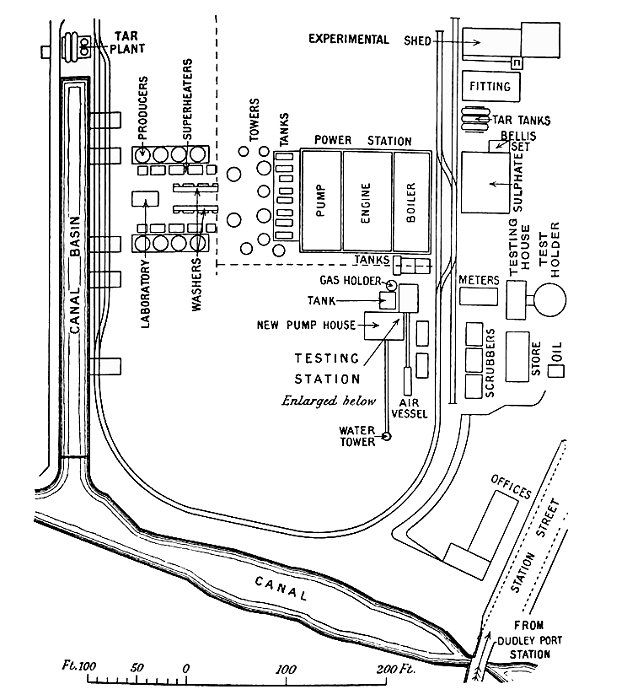
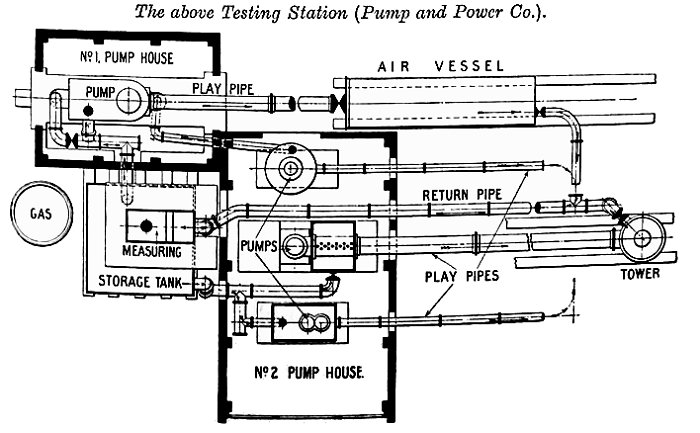
The
air-blast for working the
producers is produced by Roots'
blowers (made by Thwaites
Brothers), of which there are
three, each of 50 hp. The
Lee-Howl water-pumps can each
pump 160 tons of water per hour.
All the fans, washers, etc., are
operated electrically, and the
works, which are run constantly
night and day, are also lighted
by electricity, the current
being generated by Westinghouse
three-cylinder vertical
gas-engines, each of 250 hp.;
the voltage is 220. There are
two of these engines, one only
running at a time, the other
being kept as a stand-by.
The three
compressors (made by Fraser and
Chalmers) are used for forcing
the gas through the mains. Each
compressor is of 450 hp., and
will compress 500,000 cubic feet
of gas per Lour. Large
quantities of steam are required
for working the plant, and this
is provided by four Climax
boilers each of 500 hp., capable
of evaporating 1,500 gallons of
water per hour, at a working
pressure of 160 lb. per square
inch. Sulphate of ammonia is
recovered by evaporation in
specially constructed stills,
the crystallized sulphate being
afterwards dried in
hydro-extractors. The gas is
measured by being passed through
rotary meters, each capable of
passing 500,000 cubic feet per
hour.
Mains
varying in size from 36 inches
in diameter at the works to 21
inches at the end of the
circuitor of the trunk main have
been laid, and are filled with
gas through Toll End, to Ocker
Hill, where the main bifurcates,
one leg passing through Bilston
into Wolverhampton, the other
leg passing through Leabrook and
Wednesbury into Walsall. Gas is
at present being distributed
under a pressure of 5 lb. per
square inch. This pressure is
reduced on consumers' premises
by means of reducing valves,
which have been specially
designed for the purpose, to the
pressure suitable for each
individual case. The trunk-mains
are of the Ferguson locking-bar
type.
All other
pipes (except specials) are made
of wrought-iron, or steel, with
screwed joints. The total length
of trunk and branch-mains laid
to end of 1909 was 251 miles.
The gas is connected to over 100
works, and is used for all kinds
of metallurgical and heating
operations, as well as for
generating power by means of
gas-engines. |
|
Trams
The first trams in Tipton were
operated by the Birmingham and District Tramways Company
Limited, formed on the 29th July, 1871. The company
constructed a 4ft. 8½ inch gauge, horse-drawn tramway
under the terms of the Birmingham and Staffordshire
Tramways Act of 1870. It ran from Hockley Brook through
Handsworth to West Bromwich. At Carter’s Green there
were two branches, one to Hill Top and another that ran
to Great Bridge and Dudley Port.
The line opened on the 20th May,
1872 but did not pay its way. The Carter’s Green to
Dudley Port section closed in December 1873 and the
track was soon removed.
On 28th November, 1878 the South
Staffordshire and Birmingham District Steam Tramways
Company Limited, later called the Staffordshire Tramways
Company Limited, was formed to construct and promote
tramways in Staffordshire. It was initially allowed to
operate steam-powered trams under the terms of the
Staffordshire Tramways Order, 1879, confirmed by the
Tramways Orders Confirmation Act, 1879. The company's
headquarters and tram depot was in Corns Street,
Darlaston, off Birmingham Street. The company also had
three small depots, one in Dudley at the end of Tipton
Road, opposite the entrance to Dudley Railway Station,
another on Holyhead Road, Handsworth, near the city
boundary, and a third in Bloxwich Road, Leamore,
Walsall, near the railway line, where the industrial
estate is today. Over the next few years, further
acts of Parliament allowed the company to build and
operate an extensive network, covering much of the Black
Country. The acts and authorised tramways
that ran through Tipton can be summarised as follows:
|
Tramways Orders Confirmation (No. 2) Act, 1881. Tramways
in West Bromwich and Great Bridge
A tramway from Carter’s
Green, West Bromwich, to the Stalk Inn on the boundary
of Great Bridge and Tipton, via Dudley Street, Great
Bridge Street, and Great Bridge.
The
South Staffordshire Tramways Order, 1881. A tramway in
Wednesbury and Tipton
From the White Horse Hotel, Bridge
Street, Wednesbury, to a terminus at the junction of
Birmingham Road and Tipton Road, Dudley. The route
followed Holyhead Road, Victoria Street, Great Western
Street, Leabrook Road, Gospel End Road, Wednesbury Oak
Road, Bloomfield Road, Dudley Road, and Tipton Road,
Dudley.
The
Dudley and Tipton Tramways Order, 1881. Tramways in
Tipton and a short length of track in Birmingham Road,
Dudley
A tramway from Great Bridge
Street, Tipton to the parish boundary in Burnt Tree
Road, via the Market Place, Horseley Heath, and Dudley
Port Road, and a tramway from Great Bridge Street, Tipton to Ocker
Hill, via the Market Place, New Road, and Toll End Road.
|
|
|
|

A steam tram passing through
Wednesbury market. |
|
The tramways had a gauge of 3ft. 6
inches, and were mostly single track with passing
places, although a few short lengths of double track
were installed. Stand pipes were also fitted between the
tracks at convenient stopping places to refill the
engines’ water tanks.
On the 12th October, 1885, the
Great Bridge to Tipton Road, Dudley section opened. The
average fare per passenger was 1.49 pence. The company's
annual profit was £2,416.
On Saturday, 10th September, 1887,
a fatal accident occurred on the reversing triangle at
the Dudley terminus. A Birmingham and Midland car was
standing on the triangle with the rear of the passenger
car just clear of the points as a South Staffs car came
down from Dudley, bound for Wednesbury. The engine took
the points, but the car jumped them and crashed into the
rear of the other engine, fatally injuring a woman
passenger who was boarding the Birmingham and Midland
car.
The last remaining steam-powered
trams operated by the company were on the Wednesbury to
Dudley via Tipton line. There were serious doubts about
electrifying the route because mining subsidence was
causing a lot of trouble and expense. In a letter
to Tipton Urban Distrect Council in June 1904, the
company stated that a report received from its mining
engineer in regard to the subsidence on this road was
of "a most unfavourable character". It stated that if
the new owners of the Bloomfield Ironworks availed
themselves of the mining rights, which went with the
property, further subsidence would take place. In the
event of electrification being proceeded with,
deflections of the line would cause a leakage of current
at the joints. Under the circumstances, the Directors
were unable to proceed with the electrification as
requested by the council.
Earlier in the year, the company
had applied to the Board of Trade for a further
extension to operate by steam power, although this had
been granted, both Tipton and
Wednesbury Councils had represented to the Board of
Trade that inhabitants of the district would prefer to
be without the service. In view of the fact that steam
operation had ceased on the Handsworth section and as
the company stated, the maintenance of all the remaining
steam services during 1903 had involved the company in
considerable loss, all remaining steam services would
end. The Wednesbury to Dudley via Tipton route closed on
the 15th June, 1904.
On the 24th January, 1903 the
company (now the South Staffordshire Tramways (Lessee)
Company Limited, extended its electrically-powered
Handsworth service to Great Bridge. The company also
began to run electrically-powered trams on the route
from Wednesbury to Dudley via Princes End on the 22nd
October, 1907.
|
|
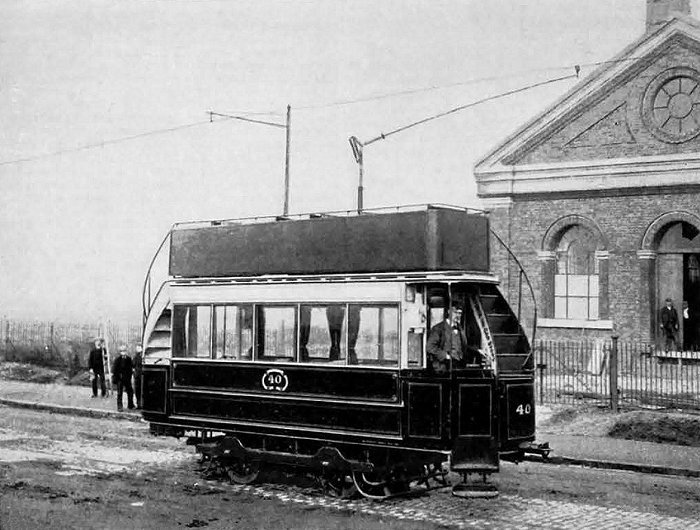
A South Staffs tram outside the
company's generating station at James Bridge. |
|
Steam-powered trams were also
operated in Tipton by the Birmingham and Midland
Tramways Company, founded on the 22nd November, 1883 to
operate over authorised lines that were to be built by
the Western Districts Company, at extremely low rates.
The lines were authorised by the Board of Trade, as the
Birmingham and Western District Tramways Order, 1881,
and confirmed by the Tramways Orders Confirmation (No.
3) Act, 1882. The lines formed a large interconnected
network with around 35 miles of track, crossing
Birmingham, Smethwick, Oldbury, Tipton, Dudley, Sedgley,
and Coseley.
The acts and authorised tramways in
Tipton can be summarised as follows:
|
Tramways Orders Confirmation (No. 2) Act, 1881. Tramways
in Birmingham
A tramway from Dudley Road,
Birmingham to Smethwick High Street and Oldbury, then to
Dudley Port Road, Dudley via Dudley Road and Tividale
Road, and ending at Dudley Market Place. The last part
of the route through Dudley Port opened on the 30th
August, 1885. Electrically-powered trams started to
operate on the route on the 21st November, 1904.
Tramways Orders Confirmation (No. 3) Act, 1882. Tipton,
Sedgley, and Coseley
A continuation of
the tramway from Dudley Road to Sedgley Road West via
Tipton Road, Sedgley Road East, Park Lane to Coseley.
|
|
The Board of Trade inspection was
carried out by Major General Hutchinson on the 1st June,
1885, and Board of Trade Certificates to allow trams to
run in Oldbury, West Bromwich, Tipton, Dudley, and
Rowley Regis were received on the 4th July, 1885.
The company’s depot was built on 3½
acres of land in Oldbury Road, Smethwick, about 300
yards west of the junction with Spon Lane. Large engine
and car sheds were built, along with a coke yard, off
Windmill Lane, Smethwick. The company purchased 34
tramway locomotives.
|
|
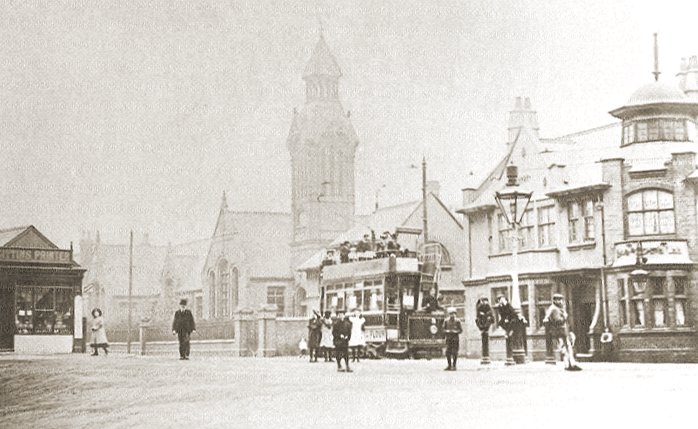
A tram in Gospel Oak Road, with
Ocker Hill Junior School in the background. From an old
postcard. |
|
Education and Schools
In the early part of the 19th
century there were many Sunday schools attached to
various churches and chapels, as well as several
privately-run schools. There were also a few others that
placed themselves under Government inspection and
received Government grants. They were known as public
elementary schools and tended to be the best local
schools of the day. They included St. Martin's School,
Lower Church Lane; St. Mark's School at Ocker Hill; St.
John’s School, Park Lane; Great Bridge Wesleyan School,
Fisher Street; Tipton Hall School; and Waterloo Street
Infants School. They could accommodate 1,943 pupils.
There were also National Schools, supported by private contributions. They were
at Horseley Heath, Ocker Hill and Tipton Green and
catered for around 500 children.
In 1871 the following schools were
supported by voluntary contributions:
Zion School, Princes End
St. Paul's New Connexion School,
Dudley Port
Mr. Beasley's Wesleyan School,
Dudley Port
Primitive Methodist School, Burnt
Tree
Bloomfield Wesleyan School
Gospel Oak Wesleyan School
Ragged School, Brown Lion Street,
Bloomfield
Summerhill Wesleyan School
The Tabernacle School, Princes End
Ocker Hill Wesleyan School
Ebenezer Independent School, Union
Street
Primitive Methodist School,
Bloomfield
Primitive Methodist School, Great
Bridge
Ragged School, Horseley Heath |
Tipton School Board was set up
in March 1871 under the Elementary Education Act 1870.
The Board held its first meeting on Thursday, 6th April,
in Lower Church Lane when members elected William Hipkins as Chairman and Samuel Millington as
Vice-Chairman. No clerk was appointed and so the Rev. S.
T. Tozer volunteered to be acting Honorary Secretary at
the board’s next meeting on the 5th July. At the
meeting, Mr. G. Wilkinson, of Lloyd's Bank, Dudley, was
appointed Treasurer. The other members were William
Bristow, James Brown, William Roberts, Joseph Cox, and
William Foster.
In 1871 the average school
attendance was only 1,146, but thanks to the Board it
rapidly increased. New schools were erected by the Board
as follows:
Great Bridge (New Road) in 1874
Dudley Port in 1877
Burnt Tree in 1880
Tipton Green in 1880
Bloomfield in 1891
Ocker Hill in 1899
Park Lane in 1903 |
The School board was eventually
superseded by the Council's Education committee. In 1886 the schools could
accommodate 3,032 pupils. The average attendance was 2,681.
Average attendance in other schools
was 2,154.
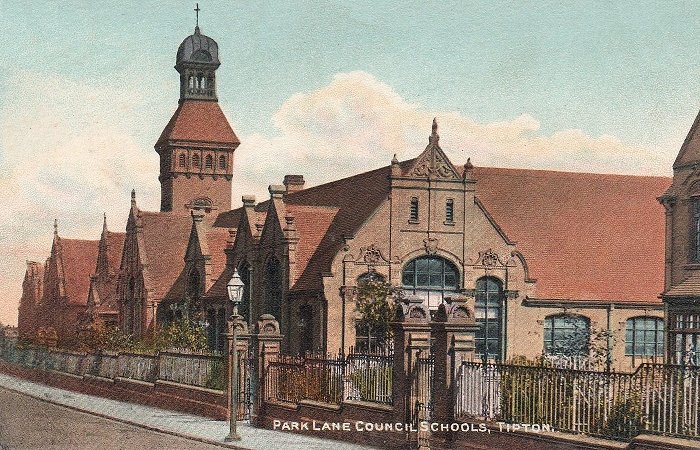
From an old postcard.
Tipton schools listed in Kelly’s
1912 Directory are as follows:
Birch Street, Park Lane, opened
January, 1905, 355 boys, 355 girls and 330 infants;
average attendance, 318 boys, 301 girls and 302 infants;
W. J. Woodall, master; Miss A. Richards, mistress; Miss
Eliza Booth, infants' mistress.
Bloomfield, Bloomfield Road
(infants), built in 1891, for 254 children; average attendance,
191; Miss Sarah Booth, mistress.
Burnt Tree, Gate Street (mixed),
built in 1880, enlarged in 1896, 415 children; average
attendance, 381; Joseph Yorke, master. Infants'
school, 330 children; average attendance, 249; Miss Florrie Goldie, mistress.
Dudley Port, built in 1877, 380
boys, 272 girls and 285 infants; average attendance, 277
boys, 246 girls and 254 infants; William
Thomas Whitehouse, master; Miss K. Swift, mistress; Miss
A. H. Yorke, infants' mistress.
Great Bridge, New Road, built in
1873, for 400 boys and 257 girls; average .attendance,
340 boys and 257 girls; Charles Henry Greenwood, master;
Miss Louisa Hickinbottom, mistress. Infants' School
built in 1887, for 256 children; average attendance,
181; Miss Elizabeth Walker, mistress.
Ocker Hill, Gospel Oak Road, built
in 1900, for 336 boys and girls and 275 infants; average
attendance, 294 boys and girls and 178 infants; Thomas
Smith, headmaster; Mrs. Keziah Woolley, infants'
mistress.
Tipton Green, Sedgley Road West,
built in 1880, for 315 boys, 296 girls and 316 infants;
average attendance, 264 boys, 259 girls and
222 infants; Arthur E. J ones, master; Miss Edith E.
Given, mistress; Miss Annie Kenny, infants' mistress.
St. John's (infants), Prince's End,
built in 1857, enlarged in 1895, for 160 infants;
average attendance, 119 infants ; Miss Emily Labram,
infants' mistress.
St. Mark's (mixed & infants),
Spring Street, Ocker Hill, built in 1858, for 500
children; average attendance, 174 mixed and 137 infants;
Richard G. Farley, master; Miss Davis, infants' mistress.
St. Martin's, Lower Church Lane,
built in 1861, for 450 boys and girls and 150 infants;
average attendance, 306 boys and girls and 117 infants;
John Smith, master; Miss Alma Bushell, infants' mistress.
St. Paul's, Wood Street, built in
1874 and enlarged in 1899, for 147 boys, 138 girls and
178 infants; average attendance, 119 boys, 108 girls and
138 infants; Samuel Kelsall, master; Miss Florence A.
Clee, mistress; Mrs. Sarah Mould, infants' mistress.
|
|
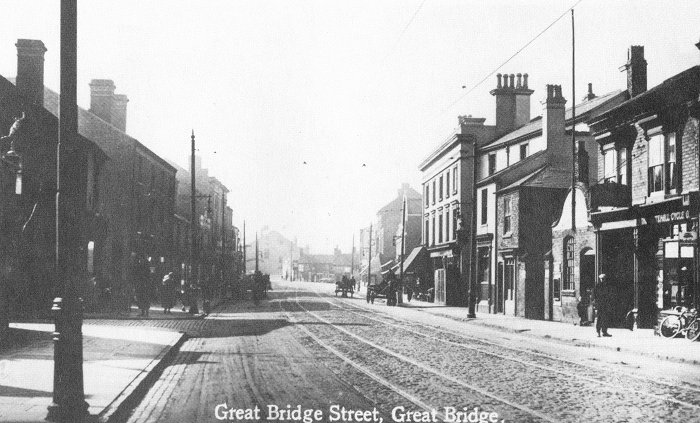
From an old postcard. |
|
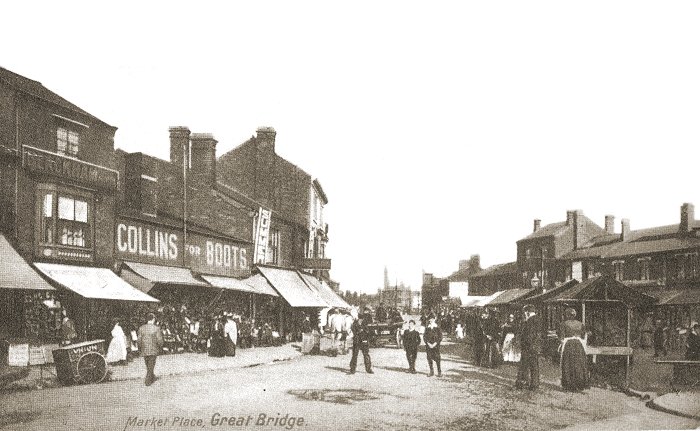
From an old postcard. |
|
 |
 |
 |
|
Return to
Industries |
Return to
the
beginning |
Proceed to
Public Houses |
|